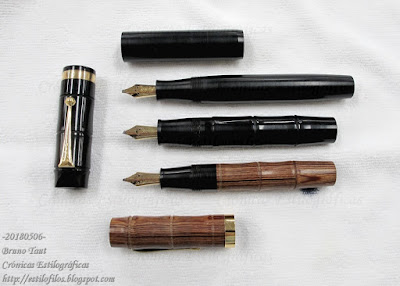In 1973, Platinum released a series of pens called Amazonas. Their selling point was that they were coated with leather of the
star-fingered toad.
In actual terms, we see forty-something years later, this was just one of the series of leather-coated pens Platinum marketed mostly between 1967 and 1979, and even beyond that as there is still a leather pen in the catalog of the brand. Most of those used sheep leather, some with some additional painted decoration, but there were also models with leather from more exotic animals: crocodile, lizard, snake...
The pens of the Amazonas series (PAM-8000 in the internal coding of Platinum) cost JPY 8000. They came in five colors: pink, red, green, light brown and dark brown. Pen-wise, they were cartridge-converters, with 18 K gold nibs with a fingernail geometry. The dimensions are as follows:
Length closed: 134 mm
Length open: 120 mm
Length posted: 147 mm
Diameter: 13.0 mm
Weight: 20.7 g (dry, with converter)
On the picture we case see two examples of these leather coated pens: one in pink and in another in light brown. The first is a very regular model with a F nib.
 Two of the leather-coated series of pens.
Two of the leather-coated series of pens.
 The pink Amazonas (possibly) with an F nib.
The pink Amazonas (possibly) with an F nib.
The light brown unit, on the contrary, is special in several ways. First, because of the three-tined music nib, and this is remarkable in itself as most of these special editions limit their range of nibs to the usual triad of F, M, and B.
 An unusual light brown lather pen.
An unusual light brown lather pen.
 The unusual music nib of the light brown leather-coated pen.
The unusual music nib of the light brown leather-coated pen.
And then, we find an unusual imprint on the cap.
 The original imprint on the cap: "DNCONSTAN PLATINUM".
The original imprint on the cap: "DNCONSTAN PLATINUM".
This engraving represents a
Byzantine coin. It shows a profile bust and part of the usual inscription in those coins: “DNCONSTAN”. It should follow with TINUSPPAV showing that those coins could belong to the mid 7th century, the period when
Constans II and
Constatin IV reigned in Byzantium; or to the mid 4th century, the times of Constatius II (vid note infra). But on this pen, the second part reads “PLATINUM”. So, “DNCONSTAN PLATINUM”.
This pen was made in 1975, according to the date on the nib.
Was this a special pen? What is the meaning of this engraving? I have no answers to these questions, and the only thing I can do is to document this rarity.
NOTE on 06/Nov/2019: A couple of days after I published this text a very kind and informed reader sent a comment correcting my many mistakes. You can read it fully on the comments, and here I extract the important elements:
(...) The coin on the pen says D N CONSTAN in the first part of the inscription; I can't read the second half of the legend, but I can believe from the picture it's PLATINVUM. That word replaces the second half of the legend, which is missing.
The coin doesn't say ON but DN: D is Dominus, N is for Noster (Our Lord). We can't tell what the rest would have been, but the coin for Constans II in the Wikipedia link is a good guess: it splits in the same place. That one reads, D(ominus) N(oster) Constan (break) tinus P(ater) P(atriae) AUG(ustus), with the final G apparently blurred into the edge.
The D N and the P P AUG are very well established elements of late Roman coins--Pater Patriae is Father of the Fatherland, Augustus is the late antique title for what we call the Roman Emperor. It is a common inscription to find. If one wanted to identify potential models, the Roman Imperial Coinage volumes would be of use--they list legends in an index, as I recall.
In my opinion, this iconography isn't that of the 7th c. but (of) the 4th--it looks like someone from Constantine I's family, my best guess being his son Constantius II's, from the 350s. See
here (...) a gold solidus with a similar bust and inscription.
Now why that particular coin is there--that I'd like to know! Who embossed the leather? Did they, like Constantius, have Arian leanings?
NOTE on 01/Aug/2020: Commenter Jyrki Muona suggested that my text implied that these pens belonged to the Amazonas series sporting some exotic leather. That could be the case of the pink unit, but is less likely so for the light brown pen with the coin decoration. In any event, it is difficult on both cases to determin the actual origin of their coatings. I have corrected my text to eliminate that ambiguity. Thanks!
My thanks to Poplicola-san. And to M Gubbins and to J. Muona.
Opus 88 with Kanwrite nib – De Atramentis Beethoven
Bruno Taut
Nakano, November 2nd 2019
etiquetas: Platinum, music nib
 Five different Sailor Mini with the same size and shape. The three top pens are GT --gold trim-- and implement 18 K gold nibs and 18 K gold plated cap bands. The lower two pens use 14 K gold nibs.
Five different Sailor Mini with the same size and shape. The three top pens are GT --gold trim-- and implement 18 K gold nibs and 18 K gold plated cap bands. The lower two pens use 14 K gold nibs.
































































